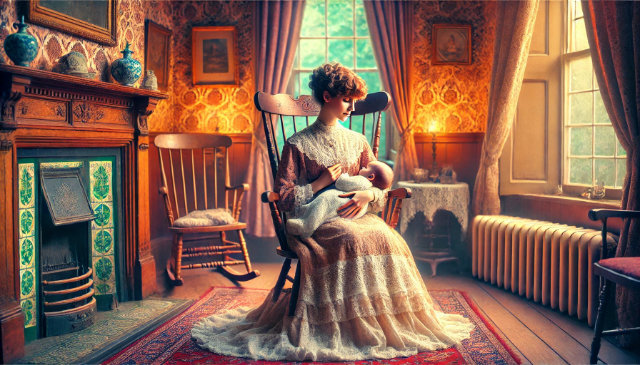The nursing chair is a piece of furniture that often flies under the radar, yet its significance in both history and modern parenting cannot be overstated. This modest, often unassuming chair has provided comfort to countless mothers and their infants over the centuries. While its design has evolved over time, the core purpose of the nursing chair remains the same: to create a peaceful, comfortable space for a mother to feed, soothe, and bond with her baby.
Origins and Evolution
The origins of the nursing chair can be traced back to the 18th and 19th centuries when they were first designed to assist mothers during breastfeeding. In those times, chairs were typically upright and rigid, designed for practicality more than comfort. The nursing chair, however, was made with a lower seat and a more reclined back, encouraging a relaxed posture ideal for holding a baby for long periods.
During the Victorian era, nursing chairs were often ornately decorated with carved wood frames and upholstered in luxurious fabrics. Though their design catered to the tastes of the time, the function remained unchanged—offering a comfortable seat for mothers. These chairs were a symbol of status and motherhood, commonly placed in nurseries or living rooms. In many ways, the nursing chair reflected societal expectations of women at the time, who were expected to provide hands-on care for their children in the domestic sphere.
The Modern Nursing Chair
As we moved into the 20th and 21st centuries, the nursing chair has evolved in both design and functionality. Today’s nursing chairs are often referred to as gliders or rocking chairs, offering smooth, gentle motion to help soothe babies and create a calming environment. Upholstery has become more practical and easy to clean, in recognition of the inevitable spills that come with caring for a newborn.
One of the key elements of modern nursing chairs is their ergonomic design. Many are equipped with supportive cushions for the back, neck, and arms, ensuring that mothers can maintain a comfortable position for feeding, which can take up a significant portion of their day. The addition of footrests or ottomans also adds another layer of comfort, promoting better circulation and reducing physical strain during long nursing sessions.
The Emotional Connection
Beyond their practical use, nursing chairs hold an emotional significance for many parents. These chairs become the setting for intimate moments between mother and child. It’s where first feedings take place, where lullabies are sung in the quiet hours of the night, and where the first precious bonds are formed. Many mothers find that the nursing chair becomes a sanctuary—a place where they can retreat with their baby, away from the distractions and chaos of the outside world.
For some families, nursing chairs are passed down through generations, taking on a sentimental value. The chair that once comforted one child can be used for the next, creating a legacy of care and nurturing. The simple act of sitting in a nursing chair, even years later, can evoke powerful memories of early motherhood and the tender moments shared with a newborn.
Versatility and Beyond the Nursery
While the primary purpose of a nursing chair is to facilitate feeding and bonding, its usefulness doesn’t end when the baby grows up. Many nursing chairs, especially the more contemporary designs, are versatile enough to remain in use long after the infant stage. They can become a favorite reading chair or a comfortable seat in the living room, maintaining their role as a place of relaxation and quiet moments.
The design of these chairs is often subtle enough to blend into any room in the house, making them more than just a nursery item. With the addition of stylish fabrics and sleek designs, nursing chairs can enhance the aesthetic of modern interiors while continuing to offer the comfort they were designed for.
Conclusion
The humble nursing chair may not be the flashiest or most talked-about piece of furniture, but it holds a place of quiet importance in the lives of countless families. Through centuries of design evolution, from the stately Victorian parlors to today’s sleek nurseries, the nursing chair has remained a constant symbol of comfort, care, and nurturing. Its true value lies not only in its physical comfort but in the intimate moments it facilitates—the simple, yet profound, connections between parent and child that define the early days of life.
In a world that moves fast, the nursing chair offers a rare opportunity for stillness and connection, serving as a gentle reminder that some of life’s most precious moments are also its quietest.

